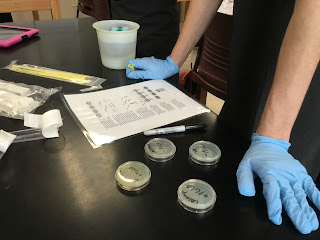Last year when we did our bacterial transformation lab, the results were lackluster at best. We had two transformed colonies on one of the LB/amp plates and one on a LB/amp/IPTG plate. We don’t have a digital water bath, and last year I struggled to keep the 42 degree water bath at 42 degrees on the hot plate. This is a heavy preparation lab to have poor results.
The kit came in to school over the summer. I stopped by occasionally to check what orders were in. Then two weeks went by without me stopping in. When I finally came by to check, the kit was already sitting in the un-air conditioned storage room including the bag of bacteria, plasmids, ampicillin, and arabinose that says to refrigerate immediately. I took these materials out and got them into a refrigerator and started to worry that the kit was ruined even before we started. I hopped onto the Facebook group to see what people said about the kit and not refrigerating the items immediately. I was surprised at how many teachers this happened to and was relieved to see that most of them had no adverse effects.
I had also shared with a colleague about how much I would like to have a digital water bath for this lab, but felt the cost was prohibitive. She suggested we try sous vide. I did some research and found an Anova Sous Vide Immersion Circulator for $109 on Amazon with good ratings and put it on our supply order. I brought in an old pot and put the circulator in. Within 10-15 minutes I had a water bath at exactly 42 degrees Celsius that remained at 42 degrees for as long as I wanted it there.
I did make a couple of other mistakes as I prepped for the lab. I started heating the LB agar in an (Ehrlemyer) flask on a hot plate. I stepped away to rehydrate the ampicillin and arabinose and heard a sizzling noise. I looked over to the hot plate to see agar erupting out of the flask. Fortunately the hot plate wasn’t plugged in behind the plate, but to the side of it, so I quickly unplugged it (and was glad I was wearing goggles, a lab apron, and closed toe shoes). Then I was panicked that I had lost too much agar to be able to pour all of the plates. I decided to scrape as much of the agar on the counter back into the flask and simmer it for 10 minutes to make sure it was sterilized. This time I stayed with it the whole time and there were no more volcanos.
My other mistake was that I rehydrated the ampicillin and arabinose with Luria broth instead of the transformation solution (calcium chloride). It wasn’t bad for these powders, but it meant I didn’t have enough broth left for my students to use in the lab. I doled it out carefully, but for the last group, I used left-over broth from the year before. (And I'm relieved to say they still had a successful transformation.)
I am happy to report that this year, we had some of our best transformation rates. I did have two groups with no transformation, but the other four had success. We certainly can’t blame the water bath!
Fortunately, I had enough agar to pour an extra LB/amp/ara plate for each lab group. We took the non-glowing transformed colonies from the LB/amp plates and swabbed them onto the spare plates. Students were able to see how the presence of arabinose really does switch on the jellyfish green protein gene when we looked at the plates the next day. This was one of our best years for this lab!









No comments:
Post a Comment